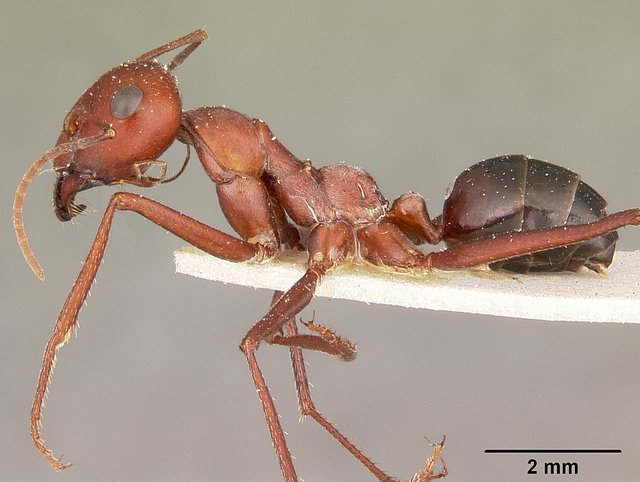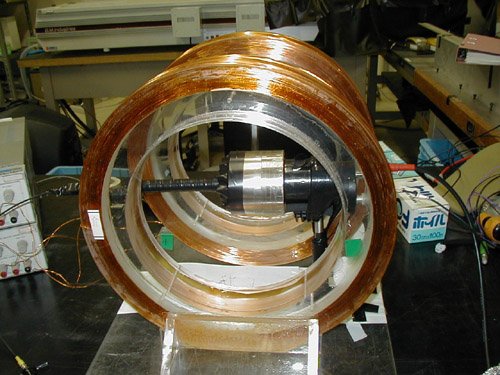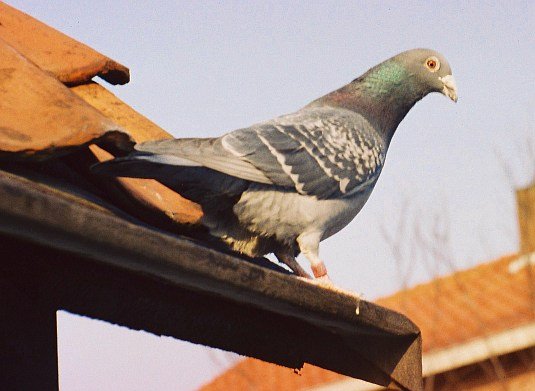A new study suggest that desert ants (Cataglyphis) use the geomagnetic field to navigate to find the nest
Desert ants (Cataglyphis) are a genus of ants which are found in Europe, Asia, and Africa, but with the most interesting species being found in the Sahara desert in the northern part of Africa. As you would expect from their name, these ants are adapted to living in deserts, particularly the deserts of very hot regions.

A Sahara Desert ant (Cataglyphis bicolor). Image by April Nobile / © AntWeb.org / CC BY-SA 3.0.
Some interesting features that some of the deserts ant species have evolved to cope with this unfriendly environment is the ability to sustain a high body temperature that can reach as high as 50 °C! Most other insects die within moments when exposed to the extreme Saharan warmth, but the deserts ants are not only able to survive; they seem to do very fine when being out of the nest in the desert. The only downside is that they have to move constantly, and they will fry if they stand still for a few moments.
The secret behind their survival in the hot temperatures are small silver-colored hairs that both increases the reflected of the near-infrared rays from the sun, but also dissipates heat from their bodies. You can see these small silver hairs in the photo up above if you look closely.
As mentioned, most insects die within a few seconds if they are exposed to the insane heat of the Saharan desert, and the desert ants actually use this to their advantage, and uses the bodies of the dead insects as their primary food source. They will run up to several hundred meters in a sinusoidal (wavy) path away from the nest to look for dead insects, but once they find the food, they will run directly towards the nest without any form of unnecessary turning.
An image from the Sahara desert. The sand here can reach over 70 degrees Celsius on the surface. Photo by mehrdad68, posted with the Creative Commons Attribution 3.0 Unported license.
Despite being very adapted at surviving in the desert, they are not perfect, and cannot survive for too long. The workers need to run out and find food rather quickly, then return to the nest with the food before they are overheated. If they are too slow, scavenge an insect that is too heavy, or just don’t find the nest quickly, they will die!
For this reason they need to also have evolved a good method of finding their way back to the nest. They have actually evolved a rather strange way of doing this, and before their first foraging trips, they will perform some “learning walks”. During this time they will explore the area close to the nest, and frequently turn their body to align in a direct alignment with the shortest route back to the nest. It kind of looks like the ant is looking back at the nest, and this makes sense to begin with, but it gets a bit stranger then they are too far away to see the nest entrance.
There have been a few theories as to exactly how the ants are able to always align themselves to look directly towards the nest, and many years after first discovering this behavior it seems like we might have found a possible answer.
The desert ants have been found to use the Earth’s magnetic field to navigate
Most scientists have assumed that the ants had been using landmarks as well as solar information such as the placement of the sun during night, or the stars during night. However, after seeing that the ants kept looking directly back at the nest even in the absence of this information, they believed that there must be another explanation as well, and the most obvious alternate explanation is that they use the Earth’s geomagnetic field.
A recent experiment done by Pauline Fleischmann and Robin Grob from Biocentre of the University of Würzburg wanted to test this further, so they traveled to a desert area in Greece where they could find desert ants without having to do the research in the scorching sun in Sahara.
To test if geomagnetic fields actually played a role in their navigation, the pair used Helmholtz coils, a decive that can be used to do things like create a magnetic field, or even cancel out Earth’s magnetic field. I’m terrible at physics, so I’m not going to explain it further, and the important thing to know is that they were able to use the device to alter the magnetic field for the ants.

This is what a Helmholtz coil actually looks like. Image is Public Domain.
Once the ants were exposed to the “fake” geomagnetic field, they no longer stopped to look directly back at the nest entrance, but rather at a new, predictable location. The scientists created a fictive nest entrance, and were successfully able to get the ants to look at this instead of the real entrance when they were exposed to the Helmholtz coil, which suggests that using the Earth’s magnetic field is a huge part of their navigation!
The results obviously lets us learn more about the desert ants, but it also raises a lot of new questions. How can a small animal like an ant process this information so quickly? When do they use geomagnetic navigation instead of relying on landmarks or the solar information? It’s clear to me that the desert ants need more research!
Remember that some birds also use the Earth’s geomagnetic field to navigate?
I just want to point out that ants are not the only animals that have been shown to be able to navigate using the Earth’s magnetic field. Just a month ago I wrote about how the passenger pigeon was found to have a protein in its eye that allowed it to carry out this task. There is also evidence that sea turtles can use the magnetic field to navigate, and many other species use geomagnetism in some form or another.

A homing pigeon, one of the birds that have been proven to be able to navigate with geomagnetism. Image is Public Domain.
At this point we have no idea if the geomagnetic navigation system found in the ants is the same as the one in the bird. The birds are dependent on a gene that codes for a protein called Cry4, but the ants might have a completely different type of mechanism behind the geomagnetic navigation.
Thanks for reading
I linked to the original paper above, but here it is again for those of you with access to Current Biology. I hope everyone found the post interesting, and I hope to see many of you in the comment section below. Thanks for reading!
About @valth
Hey, I'm @valth - the author of this post. I love to write about nature, biology, animals, nature conservation, ecology and other related branches of science, and I occasionally write about my life, about Steem or about random stuff as well. I'm trying my best to write at least one post every day, so make sure to give me a follow if you enjoy my content and want to see more of it.
Join the @valth community!
I love nothing more than to engage with my readers, so please join the @valth community in the comment section. You will definitely find more information about the topic, personal experiences, questions, and even opposing views down there, so don't miss out on learning more.
I always reward users who post good comments, so please take the opportunity to share your views and get a small upvote in exchange for it.
Greatly interesting post about desert ants. It's amazing how their body temperature can reach as high as 50 degree C, and further, how amazing is their navigation system...so in this way, even some insects have more capabilities than human beings :)
...........................................................................................................
I am glad to meet you @valth. I am scientist, a physicist, and I love to read about science, and from your profile, I can see you have great science-related posts.
I'm glad you liked the post, @mkam.
That's correct. Insects have a pretty different way of doing navigation, and some species can also navigate really good by using their smell, hearing or other senses.
And I'm really happy to hear that you enjoy my posts! I'm glad to have met you too, @mkam.
A lot of ideas here occurring to me.
First off, I want to homogenize a bunch and see if what sort of heat adaptations they have on proteomic level.
Second, as the authors in that first paper mention, their reflective adaptations have a lot of potential for biomimetic materials.
Third, I really wonder what mechanism they use for sensing the magnetic fields. I went to the NCBI to see if I could compare their genes with other magento-sensing animals, but they haven't really been sequenced yet. Add that to evidence for the utility of an Earth Genome Project.
Yep, definitely grounds for lots of further research here.
Thanks for checking the NCBI for the genetic data by the way. I was actually thinking that it could be possible to check for the Cry4 gene in these ants from that website, so it's unfortunate that they have not been sequenced yet.
What can I say, great minds think alike.
Hehe :) It's too bad that it was not there though. It would have been really cool to check.
Those ants are so amazing. I have always been amazed for those little ones. They can do so many things regardless of their tiny body!
Yeah, it's really incredible how they are able to do such seemingly complex things with their tiny bodies and brains.
Amazing discovery! Nature always finds a way to surprise us! Now you got me curious on how their navigation actually works...
Great post @valth! :D
It got me curious as well. But their genome has not been sequenced yet, so it seems like we will need to wait before we can learn how they are able to do this.
Ants are indeed incredible creatures! I am always interested in learning a little more about them, as I am fascinated by their societies. So, it has been great to learn how they always manage to get back home and keep everything going :) Thank you for the post @valth.
I agree that studying social behavior in ants is extremely interesting. And I'm glad you liked the post, @abigail-dantes!
It has been a while. I hope you and your family are doing well. Good to find you here :)
Oh! Look who is here 😍 This message just made me smile.
Thins are all good now @churchboy, I am getting organised and little by little getting back to Steemit! Here is a mid-week kiss for you 😘🌷
Thank you for the reply. It made me smile too. I'm glad things are getting better. All the best dear. Here is one for you too 😘
Leaves me with mixed feelings. It s awesome, how animals interact or react on conditions, we wouldn't even know about without our technical possibilities. On the other hand this leads to the question what human kind already destroyed or destroys right now, before we re even able to understand the connections. The oceans Currents, rural areas soaked in Round Up, genetic manipulated corn mixes with natural varieties by force, crossbreeded bees that turn out different than expected, just to name a few. Don't wanna sound too pessimistic but my trust in humanity is scattered when in 2018, there are still people consider it sexy to go hunting and the rain forest still gets rocket launched for genetic crippled cows for fast food... I have to stop here, hope you got the point. It s wonderful and sad in the same time for me.
I definitely get the point. There are so many species that are going extinct every day, and we have probably lead a lot of undiscovered species to extinction due to us cutting down so much jungle and other biodiverse habitats. It's sad that we will never know what secrets these species had.
Bearing the heat of 50 Degree C at desert is unbelievable. So the ants are not only sustain heat but they are intelligent enough to use geomagnetic-field-to-navigate. Such an amazing futures like pigeon.Amazing discovery
Yeah, it's next to crazy that they are even able to survive in those conditions. They are truly remarkable animals!
Absolutely amazing. So little beings able to use the earth magnetism for their advantage...evolution at its best:)
It's really incredible that they are able to do this when you think of their size. Definitely shows that evolution can lead to some amazing things!
It was interesting to read your observations and thoughts.
I learned a lot for myself.
Thank you, @valth for your informative articles.
Had little thought about such problems.
With respect, @singa
I'm glad you liked the post, @singa! Thanks for stopping by :)
Even the bees and homing pigeon all tend to have an inbuilt gps which they use to find their way home. Man used to have a sense of direction and an innate ability to find their way home but gps, maps have rendered this ability void :)